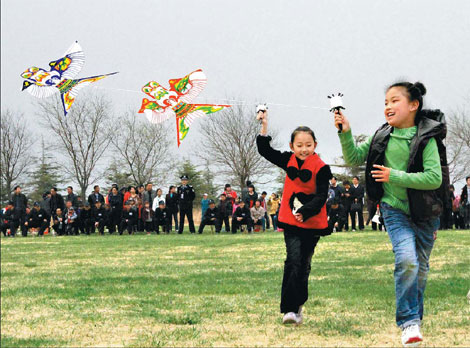Tips and Articles
Blowing in the wind
Updated: 2011-04-26 07:55
By Li Jing (China Daily)
|
Two girls fly traditional swallow kites during the 28th Weifang International Kite Festival. Photos by Wang Qian / China Daily |
German kite enthusiast Andreas Fischbacher was in his element on the weekend of April 16-17 when he attended arguably the world's most famous kite festival. The 24-year-old journeyed to Shandong province, for the 28th Weifang International Kite Festival, which attracted more than 100,000 people from 29 countries and regions between April 12 and 17.
"I was into kites when I was 10," he grins. "My mother, a dress maker, showed me how to make and fly kites.
"I have been to many international competitions all over the world, including Vietnam and Malaysia, and Weifang was a great experience."
Kites do not have a long history in Germany, he says, but are growing in popularity.
"There are around 80 kite associations and 10 festivals during a year. Some are international ones, which attract worldwide kite players," Fischbacher says. "In Germany, it is a sport for everyone, from children to senior citizens."
According to ancient Chinese texts, the kite was developed by the famous philosopher Mozi about 2,500 years ago and improved by a renowned carpenter Lu Ban in the 5th century BC.
At first, kites were used for military purposes and during the Southern Dynasty (AD 420-589), soldiers used kites to send rescue signals.
During the Tang Dynasty (AD 618-907), flying kites became a recreation. People tied bamboo instruments on kites and different musical tones would ring out in the air. Because the kites sounded like a koto instrument, people began to call them fengzheng, or "wind koto".
After the Tang Dynasty, Chinese kites started to spread around the world and by the end of the 13th century, Italian traveler Marco Polo introduced stories of kites to Europe.
In China, flying kites is still a way to express best wishes and hopes for the future. Spring is the time for kite flying, and people attach pictures and words to their kites symbolizing their dreams of longevity and good luck.
In the West, kites were often used for other practical uses in science and meteorology. In 1750, Benjamin Franklin designed an experiment to prove that lightning is electricity by flying a kite into a lightning storm. In Britain, kites were used to test theories of aerodynamics and in the 1920s the British navy used kites for military observation.
Specials

Models gear up car sales
Beauty helps steer buyers as market accelerates.

Urban breathing space
City park at heart of industrial hub positions itself as top tourism attraction

On a roll
Auto hub Changchun also sets its sight on taking lead in railway sector
